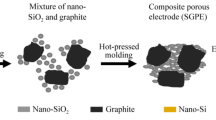Abstract
In this investigation, we have attempted a novel solution-based strategy to prepare nanostructured silicon oxide@nickel oxide (SiO2@NiO) composite by incorporating NiO into the matrix of the laboratory glass-waste-derived SiO2. The crystal structure and surface functional groups of the prepared composite were investigated by X-ray diffraction (XRD), Raman and Fourier transformed infrared (FT-IR) spectroscopic studies. The morphology of the SiO2@NiO composite examined by scanning electron microscope (SEM) showed uniform distribution of spherical particles with pore size in the range of 120–160 nm. High-resolution transmission electron microscope (HR-TEM) analysis revealed the presence of hollow transparent spherical SiO2 grains entrenched with ultrafine NiO particles homogenously. The electrochemical performance of the SiO2@NiO composite as anode material for lithium storage was tested by assembling a CR2032-type coin cell. The cyclic voltammetry studies revealed the excellent electrochemical performance of the SiO2@NiO composite electrode. It is found that the fabricated half-cell delivered a reversible capacity as high as 1000 mA h g−1 at 0.2 C with remarkable Coulombic efficiency of 99%. The SiO2@NiO heterostructure electrode exhibited an appreciable capacity retention of 80% (780 mA h g−1) even at the end of 100th charge/discharge cycle. The excellent electrochemical performance of the SiO2@NiO anode could be attributed to the simultaneous reactions of Li with SiO2, Si, and NiO involving both alloying and conversion mechanisms.







Similar content being viewed by others
References
Su X, Wu Q, Li J, Xiao X, Lott A, Lu W, Sheldon BW, Wu J (2014) Silicon-based nanomaterials for lithium-ion batteries: a review. Adv Energy Mater 4:1300882
Armand M, Tarascon J-M (2008) Building better batteries. Nature 451:65, 652, 657
Notter DA, Gauch M, Widmer R, Wäger P, Stamp A, Zah R, Althaus H-J (2010) Contribution of Li-ion batteries to the environmental impact of electric vehicles. Environ Sci Technol 44:6550–6556
Zhou L, Zhang K, Hu Z, Tao Z, Mai L, Kang YM, Chou SL, Chen J (2018) Recent developments on and prospects for electrode materials with hierarchical structures for lithium-ion batteries. Adv Energy Mater 8:1701415
Duraisamy E, Gurunathan P, Das HT, Ramesha K, Elumalai P (2017) [Co (salen)] derived Co/Co3O4 nanoparticle@ carbon matrix as high-performance electrode for energy storage applications. J Power Sources 344:103–110
Weppner W (2003) Engineering of solid state ionic devices. Ionics 9:444–464
Kammampata SP, Thangadurai V (2018) Cruising in ceramics-discovering new structures for all-solid-state-batteries-fundamentals, materials, and performances. Ionics 24:639–660
Mauger A, Julien CM (2017) Critical review on lithium-ion batteries: are they safe? Sustainable? Ionics 23:1933–1947
Chang W-S, Park C-M, Kim J-H, Kim Y-U, Jeong G, Sohn H-J (2012) Quartz (SiO2): a new energy storage anode material for Li-ion batteries. Energy Environ Sci 5:6895–6899
Zhou X, Yin YX, Wan LJ, Guo YG (2012) Self-assembled nanocomposite of silicon nanoparticles encapsulated in graphene through electrostatic attraction for lithium-ion batteries. Adv Energy Mater 2:1086–1090
Favors Z, Wang W, Bay HH, George A, Ozkan M, Ozkan CS (2014) Stable cycling of SiO2 nanotubes as high-performance anodes for lithium-ion batteries. Sci Rep 4:4605
Lee G, Kim S, Kim S, Choi J (2017) SiO2/TiO2 composite film for high capacity and excellent cycling stability in lithium-ion battery anodes. Adv Funct Mater 27:1703538
Gao B, Sinha S, Fleming L, Zhou O (2001) Alloy formation in nanostructured silicon. Adv Mater 13:816–819
Sun Q, Zhang B, Fu Z-W (2008) Lithium electrochemistry of SiO2 thin film electrode for lithium-ion batteries. Appl Surf Sci 254:3774–3779
Li X, Dhanabalan A, Meng X, Gu L, Sun X, Wang C (2012) Nanoporous tree-like SiO2 films fabricated by sol–gel assisted electrostatic spray deposition. Micropo Mesopor Mat 151:488–494
Yan N, Wang F, Zhong H, Li Y, Wang Y, Hu L, Chen Q (2013) Hollow porous SiO2 nanocubes towards high-performance anodes for lithium-ion batteries. Sci Rep 3:1568
Zhang J, Zhang X, Zhang C, Liu Z, Zheng J, Zuo Y, Xue C, Li C, Cheng B (2017) Facile and efficient synthesis of a microsized SiOx/C core–shell composite as anode material for lithium ion batteries. Energy Fuel 31:8758–8763
Wang Y, Zhou W, Zhang L, Song G, Cheng S (2015) SiO2@ NiO core–shell nanocomposites as high performance anode materials for lithium-ion batteries. RSC Adv 5:63012–63016
Wang J, Bao W, Ma L, Tan G, Su Y, Chen S, Wu F, Lu J, Amine K (2015) Scalable preparation of ternary hierarchical silicon oxide–nickel–graphite composites for lithium-ion batteries. ChemSusChem 8:4073–4080
Prasath A, Elumalai P (2016) Extraction of nanostructured SiO2 from glass waste: a potential anode source for lithium–ion batteries. Chemistry Select 1:3363–3366
Soumyadipta R, Srabanti G, Sayantani C, Soumya SM, Moulikac SP, Subhash CB (2013) Controlled synthesis of spin glass nickel oxide nanoparticles and evaluation of their potential antimicrobial activity: a cost effective and eco-friendly approach. RSC Adv 3:19348–19356
Lee LE, Wachs EI (2008) In situ Raman spectroscopy of SiO2-supported transition metal oxide catalysts: an isotopic 18O-16O exchange study. J Phys Chem C 112:6487–6498
Das HT, Mahendraprabhu K, Maiyalagan T, Elumalai P (2017) Performance of solid-state hybrid energy-storage device using reduced graphene-oxide anchored sol-gel derived Ni/NiO nanocomposite. Sci Rep 7:15342
Ren Y, Li M (2016) Facile synthesis of SiOx@ C composite nanorods as anodes for lithium ion batteries with excellent electrochemical performance. J Power Sources 306:459–466
Liu H, Wang G, Liu J, Qiao S, Ahn H (2011) Highly ordered mesoporous NiO anode material for lithium ion batteries with an excellent electrochemical performance. J Mater Chem 21:3046–3052
Acknowledgements
The authors acknowledge the Central Instrumentation Facility of Pondicherry University.
Funding
AS receives from the Science and Engineering Research Board (SERB), Government of India, the National Post-Doctoral Fellowship (PDF/2016/002815). PE receives from the SERB, Government of India, the research grant EMR/2016/001305.
Author information
Authors and Affiliations
Corresponding author
Additional information
Publisher’s note
Springer Nature remains neutral with regard to jurisdictional claims in published maps and institutional affiliations.
Rights and permissions
About this article
Cite this article
Prasath, A., Selva Sharma, A. & Elumalai, P. Nanostructured SiO2@NiO heterostructure derived from laboratory glass waste as anode material for lithium-ion battery. Ionics 25, 1015–1023 (2019). https://doi.org/10.1007/s11581-019-02879-9
Received:
Revised:
Accepted:
Published:
Issue Date:
DOI: https://doi.org/10.1007/s11581-019-02879-9




